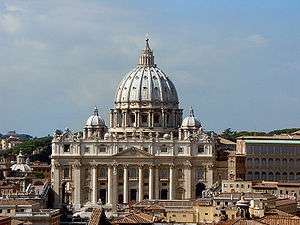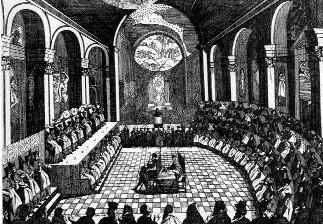Orientalium Ecclesiarum
| Second Vatican Ecumenical Council Concilium Oecumenicum Vaticanum Secundum (Latin) | |
|---|---|
 Saint Peter's Basilica Venue of the Second Vatican Council | |
| Date | 11 October 1962 – 8 December 1965 |
| Accepted by | Catholic Church |
Previous council | First Vatican Council |
| Convoked by | Pope John XXIII |
| President |
Pope John XXIII Pope Paul VI |
| Attendance | up to 2,625[1] |
| Topics | The Church in itself, its sole salvific role as the one, true and complete Christian faith, also in relation to ecumenism among other religions, in relation to the modern world, renewal of consecrated life, liturgical disciplines, etc. |
Documents and statements |
Four Constitutions:
Three Declarations:
Nine Decrees:
|
| Chronological list of ecumenical councils | |
| Part of a series on |
| Ecumenical councils of the Catholic Church |
|---|
 Renaissance depiction of the Council of Trent |
| Antiquity (c. 50 – 451) |
| Early Middle Ages (553–870) |
| High and Late Middle Ages (1122–1517) |
| Modernity (1545–1965) |
|
|
Orientalium Ecclesiarum is the Second Vatican Council's Decree on the Eastern Catholic Churches. One of the shortest conciliar documents, it was approved by a vote of 2,110 to 39 and promulgated by Pope Paul VI on November 21, 1964. "Orientalium Ecclesiarum" is Latin for "of [the] Eastern Churches," and is taken from the first line of the decree, as is customary with Roman Catholic official documents. The decree recognizes the right of Eastern Catholics to keep their own distinct liturgical practices while remaining in full communion with the Holy See. The decree exhorts Eastern Catholics to "take steps to return to their ancestral traditions." This aspect of the decree was directed against Latinisation.[2]
The document specifies some of the autonomous powers of the Eastern Churches. In particular, the Patriarch (or where applicable, major archbishop) and synod have the power to establish eparchies, to nominate bishops within their patriarchate, to legislate the rights and obligations of the minor orders (including subdiaconate), and to determine the date for celebrating Easter within their rite. It furthermore recognized the ancient practice in the East regarding the sacrament of confirmation (Chrismation), stating that all Eastern priests have the power to administer this sacrament using chrism blessed by a bishop. One of the implications of this is the further practice of infant communion was formally recognized.
Contents
The numbers given correspond to the section numbers within the text.
- Preamble (1)
- The Individual Churches or Rites (2-4)
- Preservation of the Spiritual Heritage of the Eastern Churches (5-6)
- Eastern Rite Patriarchs (7-11)
- The Discipline of the Sacraments (12-18)
- Divine Worship (19-23)
- Relations with the Brethren of the Separated Churches (24-29)
- Conclusion (30)
Notes
- ↑ Cheney, David M. "Second Vatican Council". Catholic Hierarchy. Retrieved 18 May 2011.
- ↑ Parry (1999), pp. 357-58
References
- Parry, Ken; David Melling, eds. (1999). The Blackwell Dictionary of Eastern Christianity. Malden, MA.: Blackwell Publishing. ISBN 0-631-23203-6.
